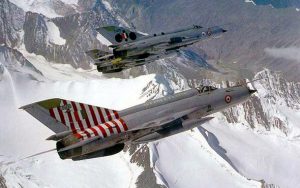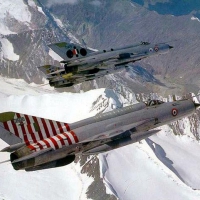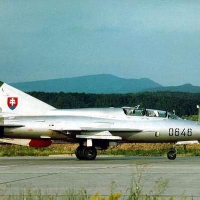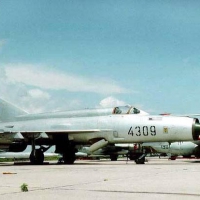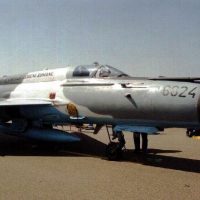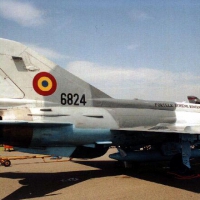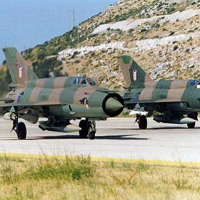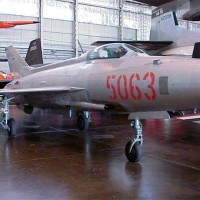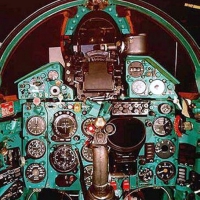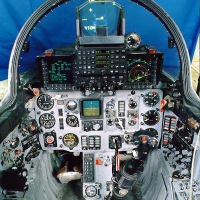MiG-21 Fishbed
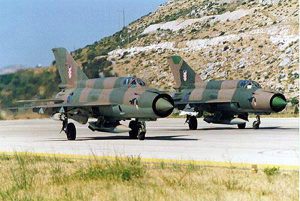 One of the most popular fighter aircraft in the world is the Mig-21, originally developed by Artem I Mikoyan and Mikhail I. Gurevich. Its design in 1955, followed by its exhibition to an impressed public at an air show the following year, was a forerunner to the hundreds of changes that were able to take place within the craft’s following 20 years of existence. Several variations of the Mig have been produced over the years and for many nations, yet the version that is the most prolific is the model MiG-21F, or “Fishbed-C”, now produced in China. This model of craft was strictly a short-range, non-inclement weather- type fighter jet with an arsenal limted to a single 30-millimeter gun. This was the prototype for many planes of this configuration produced for China, Finland, and India’s air force. The latter eventually made ample use of the MiG-21PF, and the addition of two 23-millimeter cannons to it greatly furthered progress of Indian air conflicts with Pakistan in 1971. As modifications to engines and structure were taking place and differing with every model produced, the Fishbed’s role also expanded into the realm of Reconnaisance. Radar warning receivers and electronic countermeasures equipment were installed in the MiG-21R to enable the craft to gather information, similar to the roles of the U.S.’ U-2, its superswift SR-71, and its EA-6 Prowler. Other countries using the plane for scouting purposes include Czechoslavakia, East Germany, Egypt, and its originator, the former
One of the most popular fighter aircraft in the world is the Mig-21, originally developed by Artem I Mikoyan and Mikhail I. Gurevich. Its design in 1955, followed by its exhibition to an impressed public at an air show the following year, was a forerunner to the hundreds of changes that were able to take place within the craft’s following 20 years of existence. Several variations of the Mig have been produced over the years and for many nations, yet the version that is the most prolific is the model MiG-21F, or “Fishbed-C”, now produced in China. This model of craft was strictly a short-range, non-inclement weather- type fighter jet with an arsenal limted to a single 30-millimeter gun. This was the prototype for many planes of this configuration produced for China, Finland, and India’s air force. The latter eventually made ample use of the MiG-21PF, and the addition of two 23-millimeter cannons to it greatly furthered progress of Indian air conflicts with Pakistan in 1971. As modifications to engines and structure were taking place and differing with every model produced, the Fishbed’s role also expanded into the realm of Reconnaisance. Radar warning receivers and electronic countermeasures equipment were installed in the MiG-21R to enable the craft to gather information, similar to the roles of the U.S.’ U-2, its superswift SR-71, and its EA-6 Prowler. Other countries using the plane for scouting purposes include Czechoslavakia, East Germany, Egypt, and its originator, the former 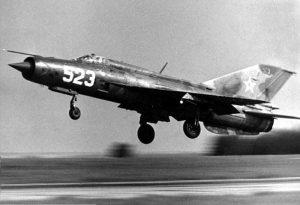 Soviet Union. The MiG-21MF model of fighter craft is a prime example of a product’s maturity as a result of consistent improvements. Avionics on the plane include a nose-type retractable conical radome, accompanied by a spear- shaped sensor vane located directly above it. Under the craft are a small air-temperature gauge to regulate fire control, as does its radio altimeter located to the rear. Weapons for the MiG are its standard 23-millimeter cannon as well as a loaded 16-rocket, 57-millimeter launcher. Air-to-air missiles like the K-13A Atoll, the R-60 Aphid, or the Matra Magic 550 can all be released from the plane’s underwing pylons. One of the few common traits that the countries of Afghanistan, Algeria, Iraq, Libya, Nigeria, and Syria share is their usage of the Fishbed in its various forms, yet primarily as a fighter aircraft. It also holds an invaluable position as a bomber or attack plane with dozens of other nations or institutions. During the war in Southeast Asia, Viet Cong air forces, backed by the Soviet Union, fought against the United States and South Vietnam using the MiG-21. Though its creator died before the end of that conflict, and the Russian government’s structure crumbled some twenty years later, this craft was still being produced in China.
Soviet Union. The MiG-21MF model of fighter craft is a prime example of a product’s maturity as a result of consistent improvements. Avionics on the plane include a nose-type retractable conical radome, accompanied by a spear- shaped sensor vane located directly above it. Under the craft are a small air-temperature gauge to regulate fire control, as does its radio altimeter located to the rear. Weapons for the MiG are its standard 23-millimeter cannon as well as a loaded 16-rocket, 57-millimeter launcher. Air-to-air missiles like the K-13A Atoll, the R-60 Aphid, or the Matra Magic 550 can all be released from the plane’s underwing pylons. One of the few common traits that the countries of Afghanistan, Algeria, Iraq, Libya, Nigeria, and Syria share is their usage of the Fishbed in its various forms, yet primarily as a fighter aircraft. It also holds an invaluable position as a bomber or attack plane with dozens of other nations or institutions. During the war in Southeast Asia, Viet Cong air forces, backed by the Soviet Union, fought against the United States and South Vietnam using the MiG-21. Though its creator died before the end of that conflict, and the Russian government’s structure crumbled some twenty years later, this craft was still being produced in China.
Development began to meet autumn 1953 official requirements for short-range interceptor; tailed delta configuration selected for production late 1956 after flight testing of prototypes with swept and delta wings; Ye-6 pre-production prototype flew late 1957; MiG-21 production authorised 1958; deliveries began late that year; production completed except in China, where developed versions are manufactured by Chengdu Aircraft Corporation (CAC) and Guizhou Aviation Industry (GAIC).Production up to 1988 totaled about 11,000 aircraft in at least 14 single-seat and three “Mongol” two-seat trainer models. The R- 11 turbojet of initial models gave way to the R-13 in the MiG-21 MF and to the R-25 in the MiG-21bis, while the series became a dual-role interceptor/ground-attack fighter in the MiG-21PFMA, and a genuine multi-role type in the MiG-21bis.
Diminutive tailed delta with clipped tips to mid-mounted wings; circular-section fuselage with prominent dorsal spine; nose intake with large three-position centrebody; swept tail, with large vertical surfaces and ventral fin; 2ø wing anhedral from roots; TsAGI section, thickness/chord ratio 5 per cent at root, 4.2 per cent at tip; leading-edge sweep 57ø; no wing leading-edge camber.
All-metal; wings have two primary spars and auxiliary spar; semi-monocoque fuselage, with spine housing control pushrods, avionics, single-point refuelling cap and fuel tank; blister fairings on fuselage above and below each wing to accommodate retracted mainwheels.
Pilot only, on zero/zero ejection seat with spring loaded arm at top which ensures that seat cannot be operated unless hood is closed. Canopy is sideways hinged, to starboard, and is surmounted by a small rearview mirror. Flat bulletproof windscreen. Cabin air-conditioned. Armour plating forward and aft of cockpit.
One Tumansky R-13-300 turbojet, rated at 41.55 kN (9340 lb st) dry and 64.73 kN (14550 lb st) with afterburning. Fuel tanks in fuselage, and two integral tanks in each wing, with total capacity of 2600 litres (687 US gallons; 572 Imp gallons), of which approx 1800 litres (475 US gallons; 396 Imp gallons) are usable within CG limits at low speed. Provision for carrying one finned external fuel tank, capacity 490 litres (130 US gallons; 108 Imp gallons) or 800 litres (211 US gallons; 176 Imp gallons), on underfuselage pylon and two 490 litre drop tanks on outboard underwing pylons. Two jettisonable solid propellant JATO rockets can be fitted under rear fuselage, aft of wheel doors.
Manual operation, with autostabilisation in pitch and roll; hydraulically boosted inset ailerons; blown plain trailing-edge flaps, actuated hydraulically; forward hinged door type airbrake each side of underfuselage below wing leading-edge; third forward hinged airbrake under fuselage forward of ventral fin; airbrake actuated hydraulically; hydraulically boosted rudder and all-moving horizontal surface with two gearing ratios for varying combinations of altitude and airspeed; tailplane trim switch on control column; no tabs.
Search and track radar (NATO “Jay Bird”) in intake centrebody, with search range of 10.8 nm (20 km; 12.5 miles). Other standard avionics include VOR, ARK automatic radio compass, IFF and Sirena 3 radar warning system with an indicator marked in 45ø sectors in front of and behind the aircraft. Gyro gunsight maintains precision up to 2.75g. Automatic ranging can be fed into gunsight. Full blind-flying instrumentation, with attitude and heading indicators driven by remote central gyro platform.
Hydraulically retractable tricycle type, with single wheel on each unit; all units housed in fuselage when retracted. Forward retracting non-steerable nosewheel unit, tyre size 500 x 180 mm; inward retracting mainwheels which turn to stow vertically inside fuselage. Size 800 x 200 mm tyres on mainwheels, inflated to approximately 7.93 bars (115 lb/sq in), ruling out normal operation from grass runways. Pneumatic disc brakes on all three wheels supplied from compressed air bottles. Steering by differential mainwheel braking. Wheel doors remain open when legs are extended. Brake parachute housed inside acorn fairing at base of rudder.
Duplicated hydraulic system, supplied by engine driven pump, with backup by battery powered electric pump, and emergency electric tailplane trim.
| MiG-21MF Fishbed J Specification | ||
| Prime contractor: | Mikoyan-Gurevich Design Bureau | |
| Country of origin: | Soviet Union | |
| NATO codename: | Fishbed J | |
| Function: | Front-line fighter | |
| Crew: | 1 | |
| Year: | 1957 (base version) | |
| In-service year: | 1970 (“MF” version) | |
| Power plant: | One Tumansky R-13-300 afterburning turbojet | |
| Thrust: | 14,520 lb. | 6,600 kg. |
| Dimensions | ||
| Wing span: | 23 ft. 4 in. | 7.15 m. |
| Length: | 51 ft. 7 in. (including nose probe) | 15.76 m. (including nose probe) |
| Height: | 13 ft 4 in. | 4.10 m. |
| Weight: | ||
| Empty | 12,855 lb. | 5,843 kg. |
| Max. takeoff | 21,560 lb. | 9,800 kg. |
| Performance | ||
| Ceiling: | Design ceiling:59,040 ft. Practical ceiling: 50,020 ft. | Design ceiling: 18,000 m. Practical ceiling: 15,250 m. |
| Speed: | 1,351 mph. | 2,175 km/h. |
| Range: | 683 miles (on internal fuel) 1,118 (with external fuel tanks) | 1,100 km. (on internal fuel) 1,800 km. (with external fuel tanks) |
| Armament | ||
| One GSh-23L 23mm two-barrel cannon with 200 rounds. Max. external weapons load of 2,000 kg. (4,400 lb.) include AAMs, bombs, rockets, or three drop tanks. Typical interceptor configuration: Two K-13A (AA-2 “Atoll”) AAMs and two R-13R (“AA-2C Atoll-C”) AAMs., or two UB-16-57 launchers for S-5 unguided rockets, or two drop tanks and two R-13M (AA-2D “Atoll-D”) AAMs., or R-13R (AA-2C “Atoll-C”) AAMs. Typical ground attack configuration: Four UB-16-57 launchers for S-5 unguided rockets, two FAB-500, and two FAB-250 S-24 unguided rockets. |
||
| Known Variants | ||
| MiG-2lbis, MiG-21bisF, MiG-21F, MiG-21FL, MiG-21J, MiG-21M, MiG-21MF, MiG-21MT, MiG-21P, MiG-21PF, MiG-21PFM, MiG-21PFM-SzPSz, MiG-21PFMA, MiG-21PFSz, MiG-21PFV, MiG-21R, MiG-21RF, MiG-21S, MiG-21SM, MiG-21SMT, MiG-21U, MiG-21UM, MiG-21USz, MiG-21USzM, MiG-21-93, MiG-21-2000 | ||
| Operators | ||
| Afghanistan, Algeria, Angola, Bulgaria, Burkina-Faso, China, Cuba, Czech Republc, Egypt, Ethiopia, Finland, Guinea, Hungary, India, Iraq, Laos, Libya, Madagascar, Mongolia, Mozambique, Nigeria, North Korea, Poland, Romania, Somalia, Sudan, Syria, Vietnam, Yugoslavia | ||
